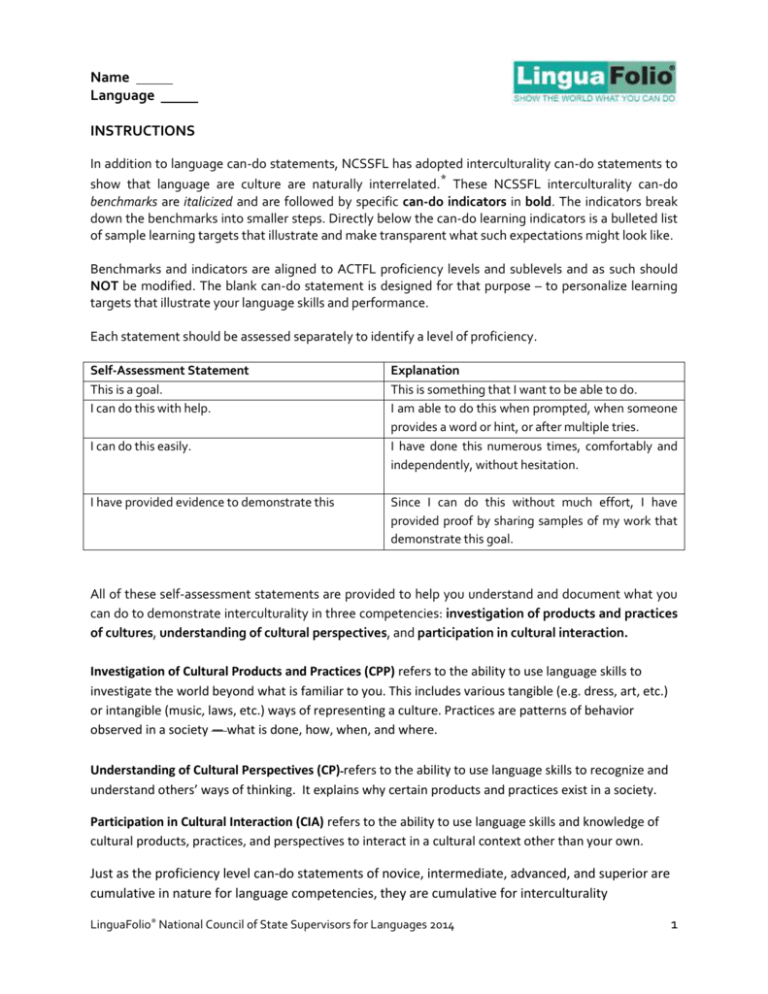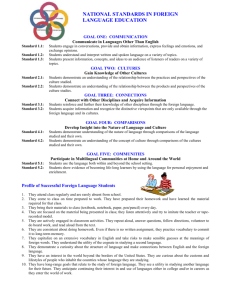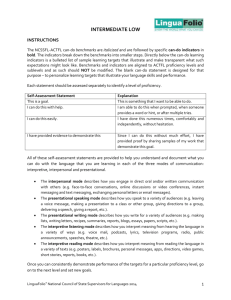Interculturality Self-Assessment Statements by Proficiency Level
advertisement

® Name Language INSTRUCTIONS In addition to language can-do statements, NCSSFL has adopted interculturality can-do statements to show that language are culture are naturally interrelated.* These NCSSFL interculturality can-do benchmarks are italicized and are followed by specific can-do indicators in bold. The indicators break down the benchmarks into smaller steps. Directly below the can-do learning indicators is a bulleted list of sample learning targets that illustrate and make transparent what such expectations might look like. Benchmarks and indicators are aligned to ACTFL proficiency levels and sublevels and as such should NOT be modified. The blank can-do statement is designed for that purpose – to personalize learning targets that illustrate your language skills and performance. Each statement should be assessed separately to identify a level of proficiency. Self-Assessment Statement This is a goal. I can do this with help. I can do this easily. I have provided evidence to demonstrate this Explanation This is something that I want to be able to do. I am able to do this when prompted, when someone provides a word or hint, or after multiple tries. I have done this numerous times, comfortably and independently, without hesitation. Since I can do this without much effort, I have provided proof by sharing samples of my work that demonstrate this goal. All of these self-assessment statements are provided to help you understand and document what you can do to demonstrate interculturality in three competencies: investigation of products and practices of cultures, understanding of cultural perspectives, and participation in cultural interaction. Investigation of Cultural Products and Practices (CPP) refers to the ability to use language skills to investigate the world beyond what is familiar to you. This includes various tangible (e.g. dress, art, etc.) or intangible (music, laws, etc.) ways of representing a culture. Practices are patterns of behavior observed in a society — what is done, how, when, and where. Understanding of Cultural Perspectives (CP) refers to the ability to use language skills to recognize and understand others’ ways of thinking. It explains why certain products and practices exist in a society. Participation in Cultural Interaction (CIA) refers to the ability to use language skills and knowledge of cultural products, practices, and perspectives to interact in a cultural context other than your own. Just as the proficiency level can-do statements of novice, intermediate, advanced, and superior are cumulative in nature for language competencies, they are cumulative for interculturality LinguaFolio® National Council of State Supervisors for Languages 2014 1 competencies as well. Learners demonstrate evidence of novice-level competencies first, and then add evidence of intermediate-level competencies and so forth. They continually add to their repertoire as they move up the proficiency continuum, applying knowledge of products and practices before developing and applying an understanding of perspectives. The interaction of language and cultural competencies thus results in interculturality. *See the KY Standard for World Language Proficiency and the SC Standard for World Language Proficiency LinguaFolio® National Council of State Supervisors for Languages 2014 2 ® I have provided evidence to demonstrate this. I can do this easily. I can identify some products and practices of cultures. This is my goal. Novice I can do this with help. Name Language INVESTIGATION OF PRODUCTS AND PRACTICES I can identify some common products related to home and community life of other cultures and my own. I can identify some geographical features of other countries. I can identify familiar landmarks. I can recognize some traditional and popular songs. I can recognize some similarities and differences between the designs of houses, buildings, or towns. I can identify specific locations to have a meal, purchase a ticket, or buy something that I need. I can recognize some similarities and differences between my daily schedule and that of a peer in another culture. I can I can identify some common practices related to home and community life of other cultures and my own. I can identify some common habits of eating in other cultures. I can identify some habits of dress in other cultures. I can express the time and date as locals do. I can sometimes use the appropriate holiday greeting. I can LinguaFolio® National Council of State Supervisors for Languages 2014 3 ® I have provided evidence to demonstrate this. I can do this easily. I can identify some basic cultural beliefs and values. This is my goal. Novice I can do this with help. Name Language UNDERSTANDING OF CULTURAL PERSPECTIVES I can identify some beliefs and values related to age, gender, social class and ethnicity. I can sometimes tell the way people address each other differently based on age and social standing. I can sometimes recognize that appropriate dress is determined by cultural traditions. I can recognize that gender and age can determine one’s role in a family, school, and the workplace. I can I can identify some characteristics of national identity. I can identify some elements of geography that define a nation. I can identify symbols that represent a nation. I can identify the importance of some historical events through their celebration on national holidays and monuments. I can identify major religions of a nation. I can I can identify ways in which cultures are globalized. I can identify some similar leisure activities across cultures. I can identify some similar forms of dress across cultures. I can identify common fast food restaurants across cultures. I can identify examples of common technology use across cultures. I can LinguaFolio® National Council of State Supervisors for Languages 2014 4 ® I have provided evidence to demonstrate this. I can do this easily. I can function at a survival level in an authentic cultural context. This is my goal. Novice I can do this with help. Name Language PARTICIPATION IN CULTURAL INTERACTION I can imitate some simple patterns of behavior in familiar settings across cultures. I can imitate appropriate greetings. I can recognize and imitate table manners. I can sometimes identify what is culturally appropriate to say when gift-giving in situations, such as at a birthday party, New Year’s, a wedding, etc. I can recognize and imitate culturally appropriate behavior in a restaurant or other public place. I can I can use memorized language and very basic cultural knowledge to interact with others. I can sometimes ask and answer questions or make simple comments in a familiar cultural context such a family event or a social event with peers. I can understand and mention a general cultural reference, such as a song or movie title, author or composer, in a conversation. I can play a simple board or card game with friends. I can I can use memorized language, and very basic knowledge of the culture to accomplish simple, routine tasks. I can use a city map, GPS, or signs to help me find my way. I can recognize and imitate how people count and use money in order to make a purchase. I can follow a team’s win-loss record from a Web site. I can LinguaFolio® National Council of State Supervisors for Languages 2014 5 ® I have provided evidence to demonstrate this. I can do this easily. I can identify common patterns in the products and practices of a culture. This is my goal. Intermediate I can do this with help. Name Language INVESTIGATION OF PRODUCTS AND PRACTICES I can explore and reference current and past examples of authentic cultural products and practices. I can understand the main idea and characters of short stories, folk tales, or graphic novels. I can recognize and reference famous artists and their works. I can understand the main idea of a movie clip or documentary. I can talk about an historical figure. I can have a simple conversation about a festival. I can summarize the contributions of a culture in a blog or multimedia presentation. I can I can compare and contrast some common products of other cultures and my own. I can describe similarities and differences in artwork. I can have a simple conversation about educational systems. I can provide basic information about countries’ governments. I can identify similarities among folk tales. I can I can compare and contrast some behaviors or practices of other cultures and my own. I can compare and contrast eating habits. I can compare and contrast how people buy and sell. I can compare and contrast how families interact. I can compare and contrast how people celebrate. I can compare and contrast how my peers socialize. I can LinguaFolio® National Council of State Supervisors for Languages 2014 6 ® I have provided evidence to demonstrate this. I can do this easily. I can compare familiar cultural beliefs and values. This is my goal. Intermediate I can do this with help. Name Language UNDERSTANDING OF CULTURAL PERSPECTIVES I can describe some basic cultural viewpoints. I can talk about the individual role of family members and the importance of birth order. I can give examples that show the importance of academics vs. sports. I can describe the importance of time vs. money. I can make simple comparisons about the roles of men and women in society. I can describe the importance of religion. I can describe how other cultures view major historical events differently. I can I can make some generalizations about a culture. I can sometimes identify cultural stereotypes or exaggerated views of a culture. I can compare some religious beliefs. I can classify the political beliefs of a nation in simple terms. I can determine which TV shows and films are popular in a given culture. I can LinguaFolio® National Council of State Supervisors for Languages 2014 7 ® I have provided evidence to demonstrate this. I can do this easily. I can interact at a functional level in familiar cultural contexts. This is my goal. Intermediate I can do this with help. Name Language PARTICIPATION IN CULTURAL INTERACTION I can handle short interactions with peers and colleagues in familiar situations at school, work, or play. I can usually accept and refuse invitations in a culturally accepted way. I can usually offer and receive gifts in a culturally accepted way. I can usually request assistance in a culturally accepted way. I can respond in a culturally accepted way when someone sneezes, toasts, or pays me a compliment, etc. I can use some appropriate cultural conventions such as body language, turn-taking, interrupting, agreeing, etc. when talking with others. I can I can recognize and refer to elements of traditional and pop culture. I can refer to a historical event. I can describe the outcome in a recent election. I can talk about a hit song. I can mention the significance of a work of art in conversation. I can describe the difference between a traditional costume and a fashion trend. I can I can sometimes recognize when I have caused cultural misunderstanding and try to correct it. I can sometimes sense when my behavior or speech has offended someone and apologize appropriately. I can sometimes recognize when I have acted or spoken too informally and try to correct it. I can sometimes recognize when my attempt at humor is misguided. I can LinguaFolio® National Council of State Supervisors for Languages 2014 8 ® I have provided evidence to demonstrate this. I can do this easily. I can explain some diversity among the products and practices in other cultures and my own. This is my goal. Advanced I can do this with help. Name Language INVESTIGATION OF PRODUCTS AND PRACTICES I can explain some of the factors that contribute to why products and practices vary across cultures. I can explain how cultural factors influence art. I can explain how popular songs reflect the culture in which they were created. I can explain how a country’s cuisine is influenced by its regional culture. I can explain how creators of advertisements use elements of culture to market their products. I can describe the use of cultural elements in filmmaking. I can I can analyze how peoples’ practices and behaviors reflect their cultures. I can explain why people worship on a certain day(s) of the week. I can explain why practices of disciplining children differ among cultures. I can explain some dietary preferences between cultures. I can explain some voting practices between cultures. I can explain why some cultures prefer certain sports. I can sometimes tell the difference between a fashion choice that is personal versus one that is a cultural norm. I can I can explore topics of personal and professional interest. I can look up some facts about the genealogy of my family in other countries. I can research study or internship opportunities abroad. I can gather information about topics of personal interest such as hobbies, music, and entertainment from those in other cultures. I can research career options and job opportunities in other countries. I can research driving regulations in other countries. I can LinguaFolio® National Council of State Supervisors for Languages 2014 9 ® I have provided evidence to demonstrate this. I can do this easily. I can analyze and explain some cultural perspectives of individuals and institutions within a society. This is my goal. Advanced I can do this with help. Name Language UNDERSTANDING OF CULTURAL PERSPECTIVES I can explain how peoples’ actions reflect their cultural beliefs. I can explain why people place importance on long vacations in some cultures. I can explain why families in some culture spend more time at meals than others. I can explain why people hold certain professions in higher regard than others. I can explain why people arrange marriages in a culture. I can I can explain how social, political, religious, and economic institutions reflect cultural beliefs. I can explain why universal health care is provided in some cultures. I can explain why a country has a democracy instead of a monarchy. I can explain why certain symbols are found on places of worship. I can explain how and why business cards are presented. I can LinguaFolio® National Council of State Supervisors for Languages 2014 10 ® I have provided evidence to demonstrate this. I can do this easily. I can interact at a competent level in familiar and some unfamiliar cultural contexts. This is my goal. Advanced I can do this with help. Name Language PARTICIPATION IN CULTURAL INTERACTION I can comfortably interact and converse with peers and colleagues at school, work, or play. I can collaborate on a project with peers from another culture. I can interact appropriately when I am a guest in the home of a friend from another culture (bring a proper gift, converse on non-taboo topics, use proper etiquette, etc.). I can engage in social conversations at a sporting event with peers. I can differentiate between appropriate and inappropriate topics and participate in conversations about most of them. I can I can interact with people in some situations outside of my normal routine. I can participate in a professional meeting in a somewhat unfamiliar situation, such as a job interview. I can participate in a community service learning project, such as volunteering at a health fair for immigrants. I can interview someone for a research project or news article. I can carry on a conversation with someone during a job shadowing experience. I can I can navigate some formal and official procedures. I can follow the steps to make an online purchase from a foreign Web site. I can help fill out forms for visas, travel and work permits, and registrations. I can explain my point of view in a minor legal procedure such as a traffic violation. I can LinguaFolio® National Council of State Supervisors for Languages 2014 11 ® I have provided evidence to demonstrate this. I can do this easily. I can interact at a competent level in familiar and some unfamiliar cultural contexts. This is my goal. Advanced (continued) I can do this with help. Name Language PARTICIPATION IN CULTURAL INTERACTION I can understand that a cultural faux pas has occurred and understand how to correct it. I can recognize when something is culturally inappropriate from the use of language, the tone of voice, or the body language. I can understand why a gift I gave was inappropriate and decide what to give the next time. I can understand why a comment I made was offensive and decide what to say next time. I can understand why what I wore was inappropriate and decide what to wear next time. I can understand why the food I served was not appreciated and decide what to serve next time. I can write an apology to repair a relationship. I can LinguaFolio® National Council of State Supervisors for Languages 2014 12








